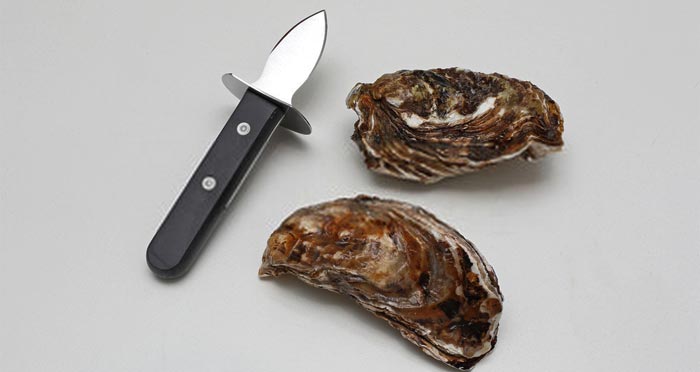For an otter, opening an oyster is no big deal. It just strikes the oyster with a stone and voila! Food is served.
But as we are humans and not an otter. So, it’s not always that easy for us. plus, it is not the most efficient and convenient way to open an oyster.
Therefore, the utensil we use for this purpose is the oyster shucker or oyster knife. Opening the oyster with a shucker becomes 10 times easier and less time-consuming.
The knife is sharp at the tip because the tip serves as the point of contact with the oyster. But the blades of the knife are not usually sharp to keep the oyster alive.
How Does it Work?
As I have already said, shucking an oyster with a shucker is 10 times easier. However, if you are eating it for the first time you can see what is shucking. The knife may slip from your hand or you may shuck the muscle form the mid.
However, once you have practiced it several times, you’ll become a pro.
Using a shucking knife is really easy.
First, you have to place a towel over the hand which you are going to use to hold the oyster so that the oyster would not slip and you’ll have less chance of getting hurt.
Then place the tip of the shucking knife on the hinge of oyster and twist it. Once the tip has entered the hinge, gently lift it. You’ll then hear a sound of “click”, this means that the hinge has now separated.
Now gently slide the flat side of the shucking knife under the top shell to completely remove it.
Make sure to insert the knife about 1 inch and keep it balanced. Otherwise, you’ll lose the oyster liquor that makes it special and delicious.
Oyster Shucker vs Clam Knife
These two knives are often thought to be the same due to their strong resemblance. However, some features make them quite different from each other. The clam knife is a long knife with a thin flat blade and has a slightly rounded tip.
The clam can be opened with any regular knife. On the other hand, the shucker is shorter with a sturdier, flat blade and a pointing tip. You can’t use any other knife to open the oyster.
Oyster Shucker vs Filleting Knives
Oyster Knives and Filleting knives are the two extremely different things and can never be used as a replacement for each other. Fillet knives have really long and sharp blades and have a slightly rounded tip.
They are flexible and can bend easily. Whereas, the oyster knives are sturdy, short and not too sharp. So, never use a filleting knife to open an oyster.
Types of Oyster Shucker
Just like the regular knives, an oyster knife comes in a variety of different types. The four most used types are:
Boston Pattern
This one is a versatile knife that can be used to shuck any size of the oyster. It comes with a short pear-shaped handle which makes the handling easier, narrow short and slightly convex blades with a slightly rounded tip. The blade is made of carbon steel and is not much sharp.
Galveston Pattern
This knife is used to shuck large oysters because of its long and wide blades. The blades are moderately sharper than Boston and have rounded tips. The handle is pear-shaped just like Boston but is a little bit longer.
New Haven Pattern
This one comes with short wide convex blades with a sharp-pointed convex tip to cleanly shuck the oyster. The handle is again pear-shaped but this time much longer than the both above.
Providence Pattern
This one also contains short and wide blades with a pointed tip and long pear-shaped handle and is used for all sizes of oysters just like the New Haven.
The only difference between the two is that the providence pattern comes with flat straight blades with no curves while the New Haven has slightly curved blades.
What to Look for in a Good Shucker
If you want to shuck the oyster like a pro, you must have the best oyster shucker. You must look for the features that make it best.
The blades shouldn’t be too sharp as we are not going to slice the meat. They should be short, wide, flat and made up of stainless steel. The tip should be slightly upturned and pointed but not curved. As for the handle, it should also be short for a better grip.
If you don’t know which shucker is best for you, you can check out the best oyster shucking knives as well. You can also shuck an oyster without an oyster shucker but that demands practice. I would recommend a shucker. Good Luck and enjoy shucking your oyster!

Hi, I’m a clinical psychologist and inclined towards best buying practices for home and kitchen things. Critical towards choosing the best product and honest with my feedback. I’m a seasoned writer having more than 4 years of experience in multiple niches as well.
Please note: CharlieTrotters.com is reader supported. This page may contain affiliate links. If you buy a product or service through such a link we earn a commission at no additional cost to you.







